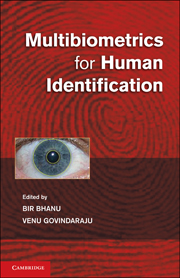Book contents
- Frontmatter
- Contents
- List of Contributors
- Preface
- Introduction
- PART I MULTIMODAL AND MULTISENSOR BIOMETRIC SYSTEMS
- 1 Multimodal Ear and Face Modeling and Recognition
- 2 Audiovisual Speech Synchrony Detection by a Family of Bimodal Linear Prediction Models
- 3 Multispectral Contact-Free Palmprint Recognition
- 4 Face Recognition under the Skin
- PART II FUSION METHODS IN MULTIBIOMETRIC SYSTEMS
- PART III HYBRID BIOMETRIC SYSTEMS
- PART IV DATABASES AND SECURITY
- PART V PERFORMANCE OF MULTIBIOMETRIC SYSTEMS
- Plate section
3 - Multispectral Contact-Free Palmprint Recognition
from PART I - MULTIMODAL AND MULTISENSOR BIOMETRIC SYSTEMS
Published online by Cambridge University Press: 25 October 2011
- Frontmatter
- Contents
- List of Contributors
- Preface
- Introduction
- PART I MULTIMODAL AND MULTISENSOR BIOMETRIC SYSTEMS
- 1 Multimodal Ear and Face Modeling and Recognition
- 2 Audiovisual Speech Synchrony Detection by a Family of Bimodal Linear Prediction Models
- 3 Multispectral Contact-Free Palmprint Recognition
- 4 Face Recognition under the Skin
- PART II FUSION METHODS IN MULTIBIOMETRIC SYSTEMS
- PART III HYBRID BIOMETRIC SYSTEMS
- PART IV DATABASES AND SECURITY
- PART V PERFORMANCE OF MULTIBIOMETRIC SYSTEMS
- Plate section
Summary
Introduction
In everyday life, human beings use hand to perceive and reconstruct surrounding environments. Therefore, its prevalence in the field of biometrics is not surprising. Along with the maturity of fingerprint and hand geometry recognition, palmprint and palm/palm-dorsa vein recognition have become new members in the hand-based biometric family. Although increasingly higher recognition rates are reported in the literature, the acquisition of a hand image usually relies on contact devices with pegs, which brings hygiene concerns and reluctance to use (Kong 2009; Morales 2008; Michael 2008). Recently a growing trend toward relieving users from a contact device has emerged, and the idea of peg-free, or further contact-free, palm biometrics has been proposed. However, accuracy of hand-based biometric systems degrades along with the removal of the peg and contact plane (Han 2007a, b; Doublet 2007; Michael 2008). The underlying reason lies in the fact that the hand is essentially a three-dimensional (3D) object with a large number of degrees of freedom. For this reason, naturally stretched-out hands of different subjects may appear substantially different on an image plane. Scale changes, in-depth rotation, and nonlinear skin deformation originating from pose changes are the most commonly encountered image variations in a touch-free environment (Morales 2008; Michael 2008).
- Type
- Chapter
- Information
- Multibiometrics for Human Identification , pp. 51 - 73Publisher: Cambridge University PressPrint publication year: 2011

